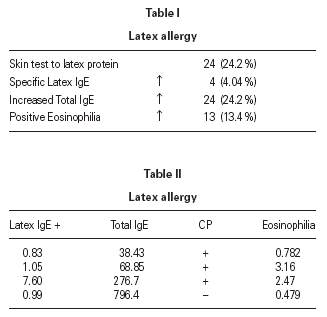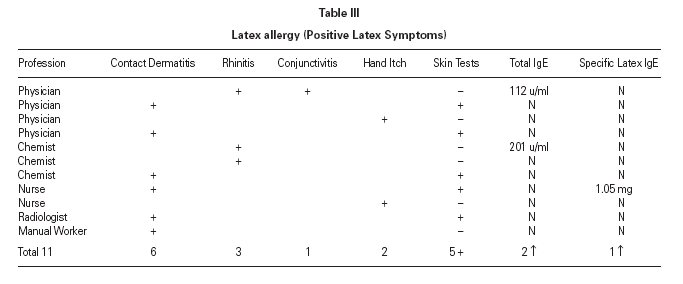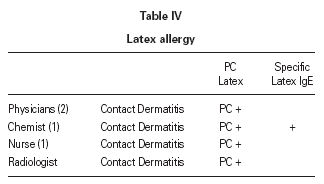INTRODUCTION
Latex or natural rubber is an intracellular cytosol chemical product secreted by numerous vegetal species of Hevea trees, commercially exploited from the tree "Hevea Brasiliensis". Cytosol is abundant in C15-1,4 poli-isoprene, immunologic inert substance. Whenever mixed with sulfide, cytosol forms poli-isoprene chains creating a polymer with high tension, elasticity, modulation and barrier capacity. Such characteristics make latex or natural rubber ideal for use in industrial and medical products 1,2,27. In addition to sulphurous additives, other accelerating, preservative and antioxidant substances may be added, such as tiuram, thiazol, phenol, benzothiazol and amino derivates 3,4, substances that cause inflammatory reaction in the skin, Contact Dermatitis as an immunologic response of hypersensitiveness type IV.
Clinic manifestations originated by latex are mainly produced by direct contact with the skin, although it may also be inhaled. It is the respiratory via which causes allergy reaction type I (positive IgE). Sensitiveness in mainly atopic patients (genetically predisposed to raise IgE), may be developed since early age from contact with certain products, such as nipples, pacifiers, balls, etc., or in health care workers who frequently use gloves and are in close contact with medical products which contain natural rubber.
OBJECTIVE
The objective of this study is to determine the prevalence of Latex Allergy in health care workers in the laboratory and surgery room of Hospital CIMA in the city of Chihuahua, Mexico.
MATERIALS AND METHODOLOGY
A crosswise study to health care workers in the surgery room and laboratory of Hospital CIMA in the city of Chihuahua, México was carried out. A total of 99 individuals with latex exposure antecedents were included, prior their written consent. Pregnant women and individuals with an illness or taking antihistamines, steroids, antileucotrienes 15 days prior to the study were excluded.
A clinical chart and physical exams were taken. Skin tests with latex antigen made at Laboratorio Aphi in Mexico City were carried out (Hevea Brasiliensis Biopol INC. Spoken. WA). The skin test was made by the scarification method together with histamine and Evans as positive-negative control, correspondingly. A blood sample was taken for a complete hematic biometry, total IgE by ELISA method (pharmacy CAP system) and IgE to latex antigen by the same method. When Total IgE turned out positive, allergy tests with other allergens to food, fungus, Hollister Lab pollens and through Prick Method were made to these same individuals.
RESULTS
A total of 99 individuals were studied, 57 women (57 %) and 42 men (42 %) with an average age of 36 years. From the total, 58 had positive family antecedents; 56 had personal and positive atopic antecedents; 34 % were physicians, 36 % nurses, 7 % chemists, 3 % manual workers, 7 % technicians, and 12 % others. Fifteen individuals in this study, reported to the questionnaire certain possibility to latex allergy manifested as dermatitis by contact, rhinitis, conjunctivitis, hand itch and hives. Nevertheless, in the general exam, only 6 individuals were found with dermatitis by contact, 2 with asthma, 2 with rhinitis, and 1 with hives. The skin tests to latex protein was positive in 24 individuals (24 %) with specific IgE to latex elevated from its normal value in 4 (4 %) individuals, while the total IgE was found higher in 24 (24 %) individuals, and 13 reported eosinophilia (table I).
Three individuals in the study, out of the 4 that reported positive to the specific latex IgE also had positive skin tests. And out of these 4 individuals, only 2 had higher total IgE, only one out of the 4 with positive specific latex IgE had elevated total IgE and eosinophilia (table II).
From the 6 individuals reporting dermatitis by contact: 2 are physicians, 1 chemist, 1 nurse, 1 Radiologist, 1 manual worker. From the 3 individuals with rhinitis, 1 is a physician and 2 are chemists. Two physicians were also found with conjunctivitis and hand itch (table III).
Table IV relates profession, illness and positive lab found.
DISCUSSION
Incidence to latex allergy in the general population is unknown although it may reach 2 % 11. Reports show that it may rise to 16 % 8,12,26 in health care workers by cutaneous tests and may come to 28-67 % 11,14,15,22 in patients with Spina Bifida, congenital urogenital abnormalities.
In the United Status, between 1988 and 1992, the FDA reported 1000 cases of systemic reactions induced to latex, 15 of which were fatal 17. It has been considered that latex consumption in the world during the first eight months of 2003 was 7,740,000 tons 5.
Presently, latex allergy is considered a public health problem, and when considering the issue "Fruit Latex Syndrome" (44), where a group of fruits such as kiwi, avocado, banana, tomato, papaya, fig, chestnut, pineapple, grape, plum, celery, (63) cross with latex allergy, the prevalence of clinical manifestations may increase. In our study with health care workers, it was found that by the cutaneous test positive to latex, 24 % resulted positive, similar data reported at other work centers 24,25.
In regards to Specific IgE to latex, 4 % was high, similar to other studies reported by the same method 27,28,29.
We conclude that the data found in this research will be useful to evaluate the personnel who attend the new hospital to receive an adequate protection for their safety. Likewise, patients attending Orthopedic and Urogenital surgery may be evaluated for the same purpose.










